

Syed Saad Andaleeb and Shiraz Latiff
The objective of this chapter is to facilitate understanding of the methods and tools available to analyze the behaviors of consumers and their decision-making processes. The chapter provides a brief description of the theories behind Consumer Behavioral Analysis. The case in the chapter will stress the applicability of these theories and tools.
The discipline of Marketing has evolved from the concept of selling which has a history as ancient as the history of human beings. The concept of selling came into existence from the times of the barter system. The gradual evolution of the selling concept saw the birth of marketing, which in turn split into a behavioral science and a strategizing science: One focused on the consumer and the other on markets and organizations.
The behavioral focus addressed the consumer and his psychology, sociology, social, cultural, and economic aspects. This science became known as Consumer Behavior and attempts to understand the buyer’s decision-making process, both as individuals and in groups. It also attempts to study the various influences on individual consumers — personal, psychological, social, and cultural — that shape needs and wants and, ultimately, affect consumption patterns. In this we recognize that the human being is not just an individual consumer who is capable of making independent decisions but is also influenced by family, friends, reference and peer groups, society and a host of additional factors. The science of Consumer Behavior attempts to study these influences and assist the marketers to better understand the decision-making process that an individual as a consumer will follow in making a purchase decision.
A definition of consumer behavior is given by Blackwell, Miniard, and Engel as follows: Consumer behavior involves the activities people undertake when obtaining, consuming, and disposing of products and services.1
Kotler provides a simple but powerful model of Buyer Behavior. First, the buyer’s characteristics influence how he or she perceives and reacts to marketing stimuli. Second, the buyer’s decision process itself affects the buying behavior.2
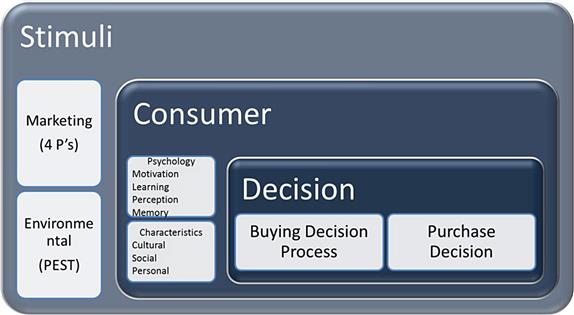
Figure 1: Consumer Decision-Making Model.
Consumer behavior includes mental, emotional, and physical activity that people use during selection, purchase, use, and disposal of products and services to satisfy their needs and desires.3
Understanding consumer behavior can be a boon to marketing managers as they can adapt the marketing mix in creative ways to influence consumer purchasing decisions. For example, if a manager determines that speed of cooking is the most important attribute of a microwave oven for a certain target group, (s)he can design the product, and create the appropriate marketing mix, that will best meet consumer needs.
Consumers, being human, display behavioral characteristics influenced by the stimuli they receive. The stimuli may come from either the product or service in the consumer’s micro or macro environment.
The micro-level perspective comprises of marketing stimuli generated by the organization through its products or services, pricing, distribution, and communication messages. The macro-level perspective consists of environmental stimuli in the consumer’s social, economic, political, and cultural ambit.
These stimuli interact with the consumers’ mind and experiences to initiate the decision-making process. These responses could be either intra-personal based on the consumer’s psychology or inter-personal based on the consumer characteristics.
The consumer decision-making process is strongly influenced by psychological, individual, social, and cultural factors (Figure 1).
The psychological factors drive consumers to interact with their world and enable them to recognize feelings, formulate opinions, and take action. Consumer psychology comprises the following four factors:
• Motivation
• Perception
• Learning
• Beliefs & Attitudes.
Motivation. Many theories are used by behavioral psychologist and marketers to determine consumers’ motivational factors. Most common among them is Maslow’s Hierarchy of Needs, which identifies five types of needs and states that we must satisfy each need, starting with the first, which deals with survival itself (food, shelter, etc.). At the next levels, physical and emotional well-being are expected to be satisfied in order to influence personal development. Once the lower order needs are satisfied, the person is interested in the higher order needs. Therefore, the level of motivation varies depending on the level of needs a person is experiencing. The consumer’s motivation to buy a product or service will depend on the type of need a product or service is expected to satisfy and if the consumer is indeed in that need-state (Figure 2).
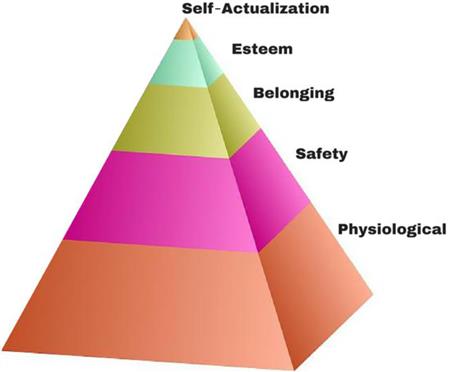
Figure 2: Hierarchy of Needs.
Perception. When exposed to stimuli, our brain attempts to make sense of it. Our perception or understanding of the stimuli depends on our interests. In other words, our perception is an approximation of reality of our own factual representation. If a consumer has had a bad health experience after consuming a certain type of ice cream, he or she would assume that the particular brand is not hygienic whenever the brand enters the consumer’s perceptual space. However, if the person is interested in buying a particular brand, he will seek it out. Since people cannot perceive every stimulus in their environment, they use selective exposure to receive certain stimuli while ignoring others. For marketers, especially advertisers, the trick is to break into that selective space to be noticed. Sometimes when the stimuli or information conflicts with their feelings or beliefs, consumer can change or distort that information. It is important, therefore, for marketers to be cognizant of the target audience’s mind-state and position all stimuli that least conflict with that mind-state. Consumers may also engage in selective retention, retaining information that accords with their personal beliefs.
Learning. Learning occurs from experience and is believed to bring change in what we hold in our long-term memory or behavior. Our experiences can thus lead to changes in behavior. A child will not walk outside barefoot if he had previously hurt himself. The painful experience leads to learning to prevent such outcomes in the future. One of the classical works on learning has been done on animals.
Pavlov’s early work on dogs led to a phenomenon termed classical conditioning. He discovered that when dogs were fed meat powder they salivated. Pavlov then discovered that if a bell was rung before the dogs were fed, they would begin salivating in anticipation of being fed. Pavlov found that after the meat had been “paired” with the meat powder enough times, he could ring the bell without feeding the dogs and they would still salivate. This is called Classical Conditioning where the dogs learnt to associate possible outcomes with previous experiences. Another learning theory of great relevance is known as instrumental (or operant) conditioning which requires an association between a stimulus and a response: the stimulus that leads to the most satisfactory response is the one that is learned. In marketing, when consumers are rewarded for purchasing a certain brand, instrumental learning occurs.
Memory and learning are intertwined. Memory involves the storage of sensory stimuli for latter recall. The sensory memory could be either long term or short term. For instance, if you meet a friend and he gives you his phone number, you will keep it in your memory until you write it down somewhere so as not to forget. Then the number is forgotten. Storage in long-term memory is achieved through rehearsing or through prolonged recall. For instance, if the friend is going to be interacting with you more often, you tend to call him more often and as a result be able to recall his number each time you need to call. Consumers too tend to recall brands in a much easier way in their decision-making process if it is in their long-term memory as opposed to a brief exposure from a commercial.
Beliefs and attitudes: Over time, people acquire specific beliefs and attitudes toward something of interest. A belief is an organized pattern of knowledge that an individual holds as true about his or her world. It is a descriptive thought. A brand image is a belief that marketers are interested in finding out because it can affect buying behavior. An attitude, on the other hand, is a learned tendency to respond consistently toward a given object. It represents favorable or unfavorable evaluations that can make people like or dislike a product or service. Attitudes are often difficult to change, for which it is easier for products to fit into existing attitudes instead of attempting to change buyer attitudes. Family planning programs in South Asia took a long time to take root because many beliefs and attitudes had to be changed, gradually, for the population to adopt birth control alternatives.
Personal characteristics refer to the individual’s age, stage in the life cycle, occupation, lifestyles, values, etc. These characteristics can influence purchase decisions. Our tastes in clothing, music, food, and even vacations can be shaped by our age. A fair-skinned person might be conscious of going out in the sun and be more inclined to use a very strong sunscreen as opposed to a darker skinned person. A blue-collar worker will have different preferences for clothing as opposed to a white-collar worker. In an environment of changing roles of men and women, gender-focused products are now a common pursuit of companies like Nike. Facial creams in Bangladesh such as Fair & Lovely and Fair & Handsome are additional examples. A person’s pattern of living, that is, lifestyle — expressed in activities, interests, and opinions — is itself of keen interest to marketers who are always searching for a relationship between their products and various lifestyle groups.3 Ikea’s products appealing to the craft-oriented self-reliant lifestylers is an example of personal influences on product choice. Finally, consumers’ self-concept combines the ideal self-image and the real self-image. Consumers seldom buy products that jeopardize their self-image.
Social class stratifies people into groups based on prestige, power, and privilege. Consumption and lifestyles vary depending on the social class people belong to. This might also be attributed to the self-actualization needs alluded to in Maslow’s Hierarchy of Needs. Certain aspirational and socially conscious decisions might not necessarily follow a logical decision-making process but rather the social norms to be adhered to.
Consumer behavior is also influenced by others, especially groups with which they engage socially or aspire to do so. Such groups are referred to as reference groups, opinion leaders, and family members from whom consumers obtain not only product information but also decision approval. Reference groups serve as a frame of reference for buying decisions and are generally recognized to influence, directly, or indirectly, a person’s attitudes or behavior. Opinion leaders can emerge within reference groups to serve as a source of informal advice on what to buy. If marketers can identify this group, they can quickly reach a broader market, which relies on these opinion shapers. The family is probably the most important source of influence on purchases. Parents and siblings serve the orientation function, influencing a variety of beliefs from religion, politics, ambitions, etc. Spouses and children are termed the family of procreation; their roles, behaviors, and influence are also monitored by proactive firms by heeding women’s complaints or studying children’s purchase tendencies.
Culture is defined as a set of behavior, norms, customs, beliefs, and values evident and followed by a set of social group. It is part of the external influences that impact a consumer. The cultural expectations of a social group has an influence on the behavioral and decision-making process of a consumer. Culture is a problematic issue for many marketers since it is inherently nebulous and often difficult to understand.
Culture is part of the external influences that impact the consumer. That is, culture represents influences that are imposed on the consumer by other individuals. The definition of culture in one textbook, is “That complex whole which includes knowledge, belief, art, morals, custom, and any other capabilities and habits acquired by any person as a member of society.”
Hofstede’s dimensions. Geert Hofstede, a Dutch researcher, found that cultural differences tended to center around four key dimensions as follows:4
• Individualism versus collectivism: To what extent people believe in individual responsibility and reward rather than having these measures aimed at the larger group.
• Power distance: To what extent there is a strong separation of individuals based on rank.
• Masculinity versus femininity: “Masculine” values involve competition and conquering nature such as large construction projects, while “feminine” values involve harmony and protection.
• Uncertainty avoidance: It involves the extent to which a “structured” situation with clear rules is preferred to a more ambiguous one.
These categorizations may not be perfect, but serve a role. For example, in societies that are more collectivistic, advertisers design appeals that focus on collective activities, for example, involving families or circles of friends.
Philip Kotler analyses the consumer decision process as a five-stage process.3 Figure 3 are the components that make up the decision-making process.

Figure 3: Consumer Decision-Making Process.
A consumer’s buying decision process has been long of interest to marketers. If the process can be influenced, it has marked ramifications for a firm’s success. The complexity of buying decision varies based on the type of product purchased and the involvement required for the decision. Some decisions are routine and habitual, while others are more deliberate and complex, requiring more time to decide. All decisions made by consumers fall within these two dimensions. The consumer decision-making process is represented by a five-step process in which the consumer proceeds in steps from recognition of a need and seeking out sources of information to the evaluation of the decision, making the purchase, and engaging in post-purchase behavior. It may be noted that consumer decisions may not proceed in the given order, and may even end at any time without a purchase decision (Figure 4).
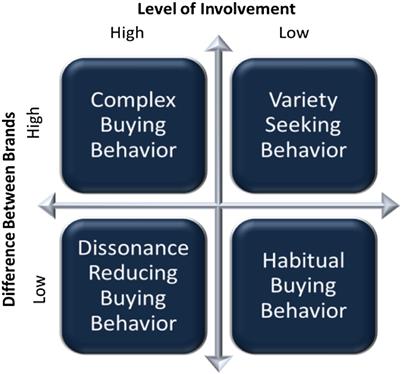
Figure 4: Buying Decision on a Matrix.
The first step in any decision-making process is problem or need recognition. This state can be triggered by internal or external stimuli. If the marketer understands the triggering mechanism, strategies can be designed to stimulate need recognition. Bakeries often allow the smell of baked goods to waft into consumer spaces that triggers a “let-me-taste-it” response. Or when the consumer realizes that his travel to work is more time-consuming by public transport, the need for a personalized travel option is recognized which marketers can use as a trigger. Any single or combination of the five senses can trigger need recognition: sight, smell, taste, touch, and/or hearing.
To solve a problem or to address a need, consumers need information. They can thus engage in internal information search, the process of information retrieval from memory to scan for prior experience or knowledge linked to the need or problem. Alternatively, the consumer may engage in external information search, relying on advertising, sales promotion, salespeople, product labels and packaging, social media, and the Internet. During external information search, the consumer can have two needs, one being that they need more information on the product and the other that they need less information on the product. If they need less information, it is because they feel they are at less risk of buying the product or spending money, they already have the knowledge they need about the product, they may already have ample experience of the product, and feel confident with their decision to either buy or not to buy.
A car buyer who realizes that buying his own car is going to solve his problem will research the types of cars available and their prices, attributes, options, etc. The information search stage should lead to an evoked/consideration set from which the decision will be made. The challenge for marketers is to find ways of being included in the evoked set.
At this stage, the consumer will compare the items in the evoked set and choose from them. One way to make a choice is to select product attributes and provide importance ratings to each. In addition, each attribute is also rated. For each product in the evoked set, multiplying each attribute score and importance rating and summing across leads to a composite score. This is known as the expectancy-value model of attitude formation combining brand beliefs and importance ratings. The product/brand with the highest summed total is the preferred product.
Another way to narrow the number of choices is to use cutoffs that a product/brand alternative must have. For example, price can be an important cutoff attribute. However, a single attribute such as price may not always be sufficient.
The marketing manager’s goal is to determine the attributes that have the most influence on consumer choice, and design an offering that stresses those attributes.
The purchase decision is made from the alternatives the person has considered. Behavioral scientists have identified that the consumers arrive on the purchase decision after having considered all options available, which is called the “Total Set.” From the “Total Set” of options available, the consumer will have, due to his own research or marketers communications effort, an “Awareness Set.” From this, the consumer will evaluate and come up with a “Consideration Set” and then a “Choice Set” to finally decide which option(s) to choose (Figure 5).
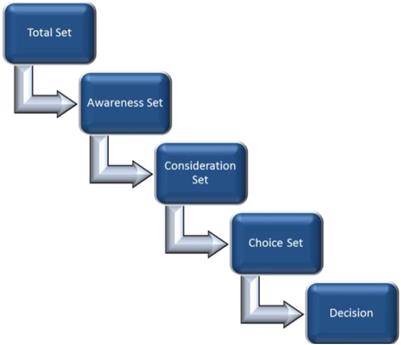
Figure 5: Purchase Decision Process.
In the purchase stage, the consumers may tend to go back and forth about their choices. This may be brought on by attitudes of others or unanticipated situational factors. Marketing can be proactive here and help influence the consumer’s choice.
Here we assume that consumers have made their purchase and moved on to the next stage, which is called Post-purchase Behavior. In this stage, the consumer may feel cognitive dissonance, which is an inner tension that a consumer experiences after experiencing something unexpected or hearing good things about another brand which was not selected. The marketer must anticipate this and use post-purchase communications to reduce product returns or order cancellations. Showing awareness and helping customers through this stage is critical.
Behavioral scientists also highlight the relevance of the AIDA model in consumer decision-making.
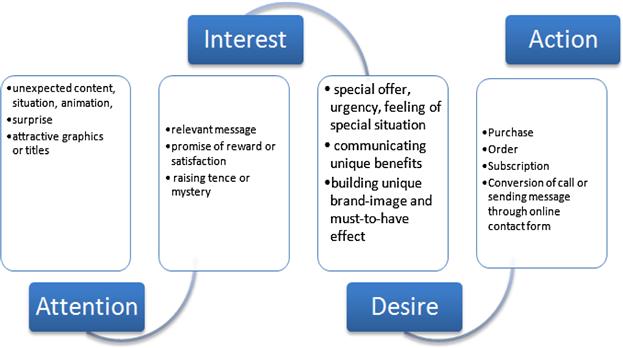
The AIDA model5 developed by Edward Strong in 1925 breaks down the sequence of events to:
• Attention
• Interest
• Desire
• Action.
In the model there are four stages that are described and shown how an advertising campaign can be successful in reaching out to its audience. First, successful marketing campaign helps grab attention. Second, it creates interest in them about the idea, product, or service. After that, it makes the product/service desirable to the potential customer. The final stage is to get the consumers to take action (i.e., purchase) as a result of their desire for the product.
Consumer behavior is influenced by many factors: Cultural, social, personal, and psychological. How these play into consumer choices is critical and must be continuously examined by marketers, especially in an era of globalization. At the same time, the purchase decision process must also be keenly understood because at each stage, marketers may be able to initiate actions that could tilt the consumer’s decision in their favor. All marketers need to recognize that the important question to ponder is: what makes the consumer tick?
Case: CONSUMER BEHAVIOR
“Diva” the Rural Sri Lankan Laundry “Queen”
Shiraz Latiff
Sri Lanka has a population of 22 million with an enviable literacy rate for the South Asian region of 90%. It has a per capita GDP of USD 1880. However, the country’s urban population is only 15% with the rest being in the rural and suburban areas. Largely, it is a subsidence agricultural economy. Tea is the main export earner, while revenues from apparel exports and migrant worker remittances also play a major part in generating foreign income. Due to lack of large scale infrastructure development projects, historically, the country’s economic activities are confined to the major metropolis like the commercial capital Colombo, and regional cities like Kandy, Galle, Kurunegala, and Gampaha around which the major urban population is distributed.
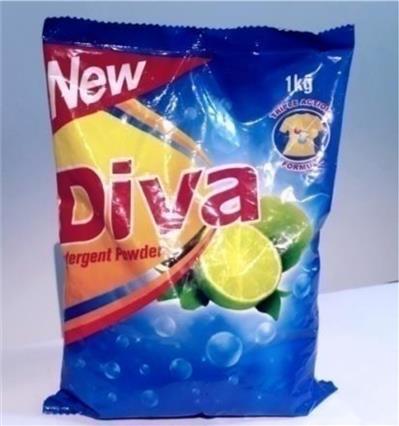
Being a tropical country, clothes need to be washed frequently. The lack of common amenities like piped water in the rural areas have resulted in common wells, riverside ghats (platforms), and bathing areas for homemakers to wash their laundry. The major multinationals have been in the country for over decades with major manufacturing outfits. Unilever is one of the major homecare brand and is omnipresent in all areas of the country. The rural market segment has always used laundry soap from the major brands to wash their linen due to their economic and convenience features.
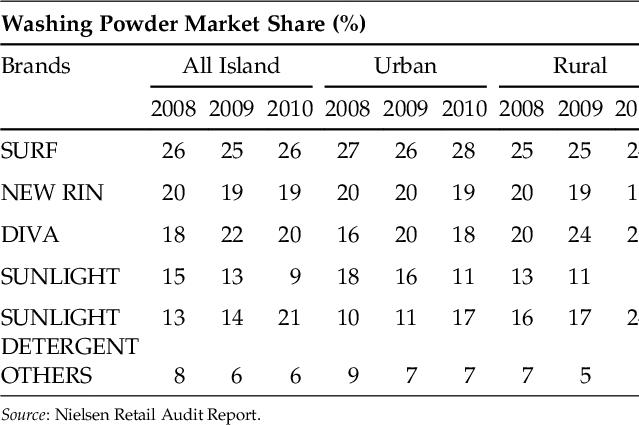
In the region, people use 85% detergents while the soap market share is as low as 15%. However, in contrast in Sri Lanka, the soap market had a share of 79% while the detergent market was only 21%.6 The disparity was due to the high price point for detergents, which was beyond the affordability of the large rural population in Sri Lanka. Although detergents had a very high performance level, the price factor was not conducive. An average household used around 12 bars of soap a month. The local consumer brand manufacturer, Hemas Group, figured out a distinct but price conscious market segment for laundry powder for its effectiveness in washing clothes, but the price was still an impediment. They found that the leading multinational brands were largely catering to households with washing machines and laundry soap was sold to the rural markets.
The typical rural house wife would either gather at the community well, the riverside or at a public water tap to wash her laundry. Some have the luxury of running water at home and wash the laundry in their homes. The usage of a laundry bar or cake of soap has always been the tradition due to lower price point for this product.
Hemas Consumer Group realized that there was a ready market in the rural segment for a low-priced convenience product in the laundry soap segment if they could offer a product to replace the bar of soap. They introduced “Diva” the laundry powder seeking to reach out to those homemakers who toiled to wash their family laundry by hand. They were the first to introduce the Diva 35 gram detergent sachet for just Rs. 5.00 in 2008. This eliminated the need for a bar of soap to be purchased for a week’s wash and instead a sachet for the day’s need at an affordable price.
The term Diva was related to the maternal figure at home and came in cakes of soaps and small sachets priced at local Rupees 5 per pack. This enabled the poor rural homemakers to buy only the day’s requirement for the washing as opposed to the more expensive competitor brands that came in larger packs and at higher price points. The convenience of using laundry detergents at an affordable price appealed to the rural homemakers and Diva became a major brand amongst the rural homemakers. Its success was recognized by the fraternity by winning the Gold Award, Product Brand of the Year, SLIM Brand Excellence Awards 2009 and the Local Brand of the Year, SLIM Brand Excellence Awards 2009a (Sri Lanka Institute of Marketing).Whilst revolutionizing Sri Lankan laundry washing habits, Diva gradually expanded its market share and today enjoys top billing as one of the top three brands in the washing powder market.
1. How do consumer characteristics influence buying behavior?
2. Compare the consumer buying process mentioned in the chapter to a product or service of your choice and discuss the relevance and exceptions.
3. Review the approach taken by Diva to identify the market opportunity and address the market segment and discuss future action the organization should take to expand the market share further.
4. Based on the consumer characteristics and the buying behavior of the Diva buyers, what other product or service opportunities would you identify for Hemas as a Fast Moving Consumer Goods (FMCG) organization?
Answer guide Q1:
The demographic and psychographic profiles the consumers belong to determine their behavioral patterns. The lifestyles, aspirations, and other motivational factors determine how the buyer will behave in making decisions in favor of the product under consideration
Answer guide Q2:
Purchasing a family car could require a longer decision-making process in terms of determining the price point which the person can afford, acquiring the information on the product, making the decision itself and post-purchase behavior. However, an impulse purchase will not necessarily require extensive information search, but rather the post-purchase cognitive dissonance, wondering if the person made the right decision or justifying the decision.
Answer guide Q3:
Diva manufacturers discovered that the homemakers in the rural markets played a vital role in ensuring the family laundry was constantly kept clean. The usage of soap and washing being done at public wells and rivers, required a smaller unit size and an easier washing agent. Hence, the small sachet of Diva was launched in the rural markets. The brand captured market share in a short time period. However, the market penetration in the urban markets have not been so great since other major players like Surf Exel are dominant in the machine wash category. Therefore, Diva might want to focus more on the rural markets rather than losing its identity in the machine wash markets.
Answer guide Q4:
The market segment this company is catering is the rural homemakers. The typical lifestyle of rural homemakers is to go to the public well to wash the laundry and have their daily baths. This also opens out an opportunity for shampoo for their hair and a soap with a moisturizer. The brand loyalty established with Diva by the company will enable to them to extend their product range the same marketing segment.